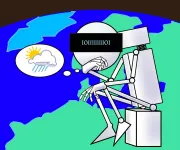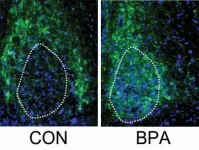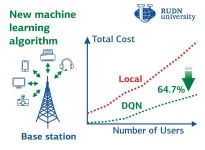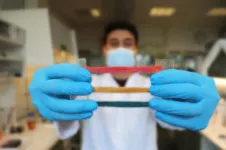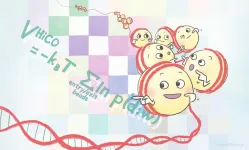(Press-News.org) Machine learning, when used in climate science builds an actual understanding of the climate system, according to a study published in the journal Chaos by Manuel Santos Gutiérrez and Valerio Lucarini, University of Reading, UK, Mickäel Chekroun, the Weizmann Institute, Israel and Michael Ghil, Ecole Normale Supérieure, Paris, France. This means we can trust machine learning and further its applications in climate science, say the authors. The study is part of the European Horizon 2020 TiPES project on tipping points in the Earth system. TiPES is administered from the University of Copenhagen, Denmark.
Man or machine
Large, complex climate models are often impractical to work with as they need to run for months on supercomputers. As an alternative, climate scientists often study simplified models.
Generally, two different approaches are used to simplify climate models: A top-down approach where climate experts estimate what impact left out functions will have on the parts kept in the reduced model. And a bottom-up approach, where climate data is fed a machine learning programme, which then simulates the climate system.
The two methods turn out comparable results. It is a challenging problem, however, to physically understand data-driven (bottom-up) approaches to fully trust them. Do machine learning programmes "understand" that they are dealing with a complex dynamical system, or are they simply good at statistically guessing the right answers?
Intelligent solution
Now, a group of scientists prove analytically and using computer simulations, that a machine learning programme called Empirical Model Reduction (EMR) in fact knows what it is doing. The study shows that this computer programme reaches comparable results to the top-down reductions of larger models because machine learning constructs its own version of a climate model in its software.
"I think what we do in this investigation is give some sort of physical evidence of why this particular data-driven protocol works. And that to me is quite meaningful, because the method has been in the atmospheric sciences for quite a long time. Yet there was still quite a lot of gaps in the understanding of the methodologies," says PhD student Manuel Santos Gutiérrez.
Encouraging and useful
The study indicates that the machine learning method is dynamically and physically sound and produces robust simulations. According to the authors, this should motivate the further use of data-driven methods in climate science as well as other sciences.
"It is a very encouraging step. Because in some sense, it means the data-driven method is intelligent. It is not an emulator of data. It is a model that captures the dynamical processes. It is able to reconstruct what lies behind the data. And that indicates these theoretical derivations give you an object which is algorithmically useful," says Valerio Lucarini, professor of statistical mechanics at the University of Reading.
The result is important in a range of fields: applied mathematics, statistical physics, data science, climate science, and complex system science. And it will have implications in a range of industrial contexts, where complex, dynamical systems are studied but only partial information is accessible - like engineering of aeroplanes, ships, wind turbines, or in traffic modelling, energy grids, distribution networks.
INFORMATION:
Note to editor:
More on TiPES: http://www.tipes.dk
The TiPES project has received funding from the European Horizon 2020 research and innovation program, grant agreement number 820970.
Reference:
M. Santos Gutiérrez, V. Lucarini, M. D. Chekroun, and M. Ghil , "Reduced-order models for coupled dynamical systems: Data-driven methods and the Koopman operator", Chaos: An Interdisciplinary Journal of Nonlinear Science 31, 053116 (2021) https://doi.org/10.1063/5.0039496
Humans are exposed to a bath of chemicals every day. They are in the beds where we sleep, the cars that we drive and the kitchens we use to feed our families. With thousands of chemicals floating around in our environment, exposure to any number is practically unavoidable. Through the work of researchers like Dr. Deborah Kurrasch, PhD, the implications of many of these chemicals are being thoroughly explored.
"Manufacturers follow standards set by regulatory bodies, it's not up to the manufacturers to prove the chemicals in consumer products are safe," says Kurrasch, a researcher in the University of Calgary's Hotchkiss Brain ...
Right-wing voices set out powerful but misleading arguments to justify inaction by the Trump administration during the COVID-19 pandemic, according to a new study of the rhetoric used by high-level government officials and influential commentators in the US during the first half of 2020.
In a study published in the DeGruyter journal Open Anthropological Research, Professor Martha Lincoln of San Francisco State University examined how public officials openly pushed for people to accept widespread illness and death from the virus by adopting a tone that suggested premature death was normal and the scale of death acceptable in the grander ...
RUDN mathematician and his colleagues from China, Egypt, Saudi Arabia, United Kingdom, and Qatar have developed an algorithm allowing the distribution of computing tasks between the IoT devices and the cloud in an optimal way. As a result, the power and time costs are reduced by about three times. The study was published in the Big Data.
With the development of technologies and devices, Internet of Things (IoT) applications require more and more computing power. The amount of data that the IoT devices need to process can be so large that it is reasonable to migrate computing to the cloud. Cloud computing provides flexible data processing and storage capabilities. But Computation offloading, meaning transferring of the resource-intensive processes ...
A DTU research team consisting of Malgorzata Gosia Pierchala, Firoz Babu Kadumundi, and Mehdi Mehrali from #TeamBioEngine headed by Alireza Dolatshahi-Pirouz, have developed a new material - CareGum - that among other things has potential for monitoring motor impairment associated with neurological disorders such as Parkinson's.
A green material with many properties
The CareGum property portfolio is incredibly broad with feats such as skin-like softness, it is stretchable up to 30,000 % and has self-healing capacities reminiscent of that of natural tissues. It is printable, moldable, and electrically conductive. Notably, the electrical conductivity enables the material to respond to external stimuli ...
Oncotarget published "STAT3 induces the expression of GLI1 in chronic lymphocytic leukemia cells" which reported that what induces GLI1 expression in GLI1-unmutated CLL cells is unknown.
Because signal transducer and activator of transcription 3 is constitutively activated in CLL cells and sequence analysis detected putative STAT3-binding sites in the GLI1 gene promoter, the authors hypothesized that STAT3 induces the expression of GLI1.
Western immunoblotting detected GLI1 in CLL cells from 7 of 7 patients, flow cytometry analysis confirmed that CD19 /CD5 CLL cells co-express GLI1 and confocal microscopy showed co-localization of GLI1 and phosphorylated STAT3. Chromatin immunoprecipitation showed ...
A series of autopsies performed in an infectious disease hospital in the Brazilian Amazon reveals that infections by the Histoplasma fungus are a major cause of death in people with HIV. The study, led by Barcelona Institute for Global Health (ISGlobal), an institution supported by "la Caixa" Foundation, in collaboration with a team in Manaus, highlights the need of implementing sensitive methods to detect these infections in Histoplasma-endemic regions.
Histoplasmosis is a lung infection caused by inhalation of spores from a fungus (Histoplasma), and is frequent in some areas of the US, Africa, and Latin America.
In the majority of individuals with a functional immune system, the infection causes mild symptoms. However, in people who are immuno-compromised, such ...
Scientists at Kyoto University's Institute for Integrated Cell-Material Sciences (iCeMS) in Japan have developed a technology that produces high-resolution simulations of one of the basic units of our genomes, called the nucleosome. Their findings were published in the journal Nature Protocols and should help improve understanding of how changes in nucleosome folding influence the inner workings of genes.
Nucleosomes are the basic structural units of DNA packaging inside the nucleus. They are formed of DNA wrapped around a small number of histone proteins. Nucleosomes move around inside the nucleus, folding and unfolding, changing their orientations, and moving closer together or further apart. These movements affect the accessibility of various molecules to DNA, determining ...
A new discovery in Ewing sarcoma, an aggressive and often fatal childhood cancer, has uncovered the potential to prevent cancer cells from spreading beyond their primary tumour site.
The breakthrough provides new insight into what triggers the process that allows cancer cells to survive while traveling through the body in the bloodstream.
Researchers with the University of British Columbia and BC Cancer have learned that Ewing sarcoma cells--and likely other types of cancer cells--are able to develop a shield that protects them from the harsh environment of the bloodstream and other locations as they search for a new place to settle, or metastasize. The study has just been published in Cancer Discovery.
"You ...
TROY, N.Y. -- As more dissolved organic matter enters lakes across the northeast United States, darkening the lakes in a phenomena called "browning," new research shows that these waters may be growing less productive and able to sustain less life. In a study published today in Limnology and Oceanography Letters, scientists found that, rather than enriching lakes with nutrients as had previously been assumed, water more heavily laden with dissolved organic matter blocks sunlight and limits plant growth.
"A key question regarding lake browning is what impact it will have on aquatic food webs, including algal growth and fisheries," said Kevin Rose, co-author ...
The brain is often likened to a computer: its hardware - neurons organized in complex circuits, its software - a plethora of codes that govern the neurons' behavior. But sometimes the brain performs exceptionally well even when its hardware seems inadequate for the task. For example, it's been puzzling how we and other mammals manage to navigate large-scale environments even though the brain's spatial perception circuits are seemingly suited to representing much smaller areas. A team of researchers from the Weizmann Institute of Science, led by Prof. Nachum Ulanovsky of the Neurobiology Department, tackled this riddle by thinking outside the experimental box. By combining an unusual research model - fruit bats - with an unusual setting - a 200 meters-long bat-tunnel - they were ...
